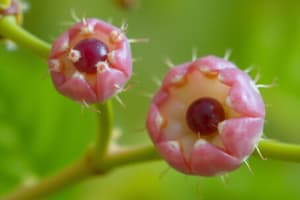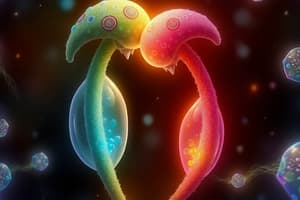Podcast
Questions and Answers
What is the main difference between sexual and asexual reproduction?
What is the main difference between sexual and asexual reproduction?
- Asexual reproduction produces offspring with genetic variation.
- Sexual reproduction requires only one parent.
- Sexual reproduction involves two parents of different sexes. (correct)
- Asexual reproduction requires gametes from two individuals.
Which of the following organisms typically reproduces asexually through budding?
Which of the following organisms typically reproduces asexually through budding?
- Hydra (correct)
- Earthworm
- Paramecium
- Amoeba
What is the term used for the female reproductive cell in sexual reproduction?
What is the term used for the female reproductive cell in sexual reproduction?
- Ovum (correct)
- Zygote
- Sperm
- Gamete
At what age range does sexual maturity typically occur for females?
At what age range does sexual maturity typically occur for females?
What is the primary function of the testes in the male reproductive system?
What is the primary function of the testes in the male reproductive system?
What reproductive structures do hermaphroditic animals have?
What reproductive structures do hermaphroditic animals have?
Which part of the sperm enables it to swim?
Which part of the sperm enables it to swim?
What type of organisms primarily reproduce through binary fission?
What type of organisms primarily reproduce through binary fission?
What is the role of the Fallopian tubes in the female reproductive system?
What is the role of the Fallopian tubes in the female reproductive system?
During which process does the zygote begin to form?
During which process does the zygote begin to form?
Which of the following statements about external fertilisation is true?
Which of the following statements about external fertilisation is true?
What structure in the female reproductive system is responsible for connecting the uterus to the vagina?
What structure in the female reproductive system is responsible for connecting the uterus to the vagina?
What happens to most eggs laid during external fertilisation?
What happens to most eggs laid during external fertilisation?
What initiates the process of internal fertilisation in the female reproductive system?
What initiates the process of internal fertilisation in the female reproductive system?
How frequently does an average ovary release an egg?
How frequently does an average ovary release an egg?
What is the primary function of the uterus in the female reproductive system?
What is the primary function of the uterus in the female reproductive system?
Flashcards
Asexual Reproduction
Asexual Reproduction
Reproduction involving only one parent.
Binary Fission
Binary Fission
A type of asexual reproduction in single-celled organisms where the cell divides into two.
Budding
Budding
A type of asexual reproduction where an outgrowth forms on a parent organism, which develops into a new organism.
Sexual Reproduction
Sexual Reproduction
Signup and view all the flashcards
Gametes
Gametes
Signup and view all the flashcards
Unisexual Animals
Unisexual Animals
Signup and view all the flashcards
Bisexual/Hermaphrodite
Bisexual/Hermaphrodite
Signup and view all the flashcards
Puberty
Puberty
Signup and view all the flashcards
Female Reproductive System
Female Reproductive System
Signup and view all the flashcards
Ovary
Ovary
Signup and view all the flashcards
Fallopian Tube
Fallopian Tube
Signup and view all the flashcards
Uterus
Uterus
Signup and view all the flashcards
Vagina
Vagina
Signup and view all the flashcards
Fertilization
Fertilization
Signup and view all the flashcards
External Fertilization
External Fertilization
Signup and view all the flashcards
Internal Fertilization
Internal Fertilization
Signup and view all the flashcards
Study Notes
Reproduction
- Reproduction is the biological process of creating offspring.
- Two main types: asexual and sexual.
Asexual Reproduction
- Involves only one parent.
- Methods include binary fission and budding.
- Binary Fission: Occurs in single-celled organisms (e.g., Amoeba, Paramecium). The cell divides into two equal halves, each with its own nucleus and cytoplasm.
- Budding: Occurs in multicellular organisms (e.g., Hydra). A new organism grows as an outgrowth (bud) from the parent, which then separates.
Sexual Reproduction
- Requires two parents (male and female).
- Individuals have specific reproductive organs and produce gametes.
- Gametes: Female gamete is the ovum (egg); male gamete is sperm.
- Unisexual Animals: Male and female gametes produced in separate individuals.
- Bisexual/Hermaphrodites: Both male and female reproductive organs in the same individual (e.g., earthworms, snails).
Sexual Reproduction in Humans
- Sexual maturity (puberty) occurs between ages 10-14 (females) and 12-16 (males).
- Male Reproductive System:
- Testes: Produce sperm; located in the scrotum.
- Sperm Duct/Vas Deferens: Transports sperm.
- Penis: Delivers semen to the female.
- Female Reproductive System:
- Ovaries: Produce ova (eggs); located in the abdominal cavity.
- Oviduct/Fallopian Tube: Transports ovum to uterus; site of fertilization.
- Uterus: Hollow, muscular organ where the zygote develops.
- Vagina: Muscular tube; birth canal.
Fertilization
- Fusion of male and female gametes to form a zygote.
- External Fertilization: Happens outside the female's body (e.g., frogs, some fish).
- Females release eggs into the water, males release sperm, and fertilization occurs externally. Large number of eggs are required.
- Internal Fertilization: Occurs inside the female's body (e.g., birds, mammals).
- Sperm travels to the egg, often via the female reproductive tract.
Zygote Formation
- Fertilized egg (zygote) develops into a new individual.
- In humans, the sperm fertilizes the ovum in the Fallopian tube.
Studying That Suits You
Use AI to generate personalized quizzes and flashcards to suit your learning preferences.




